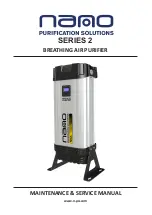
-SCS C
ONDENSER
IOM
M
ANUAL
12
Figure 8. Piping Installation
Figure 9. Dual Riser Piping
2.5.1.2
Liquid Line
The velocity of refrigerant in the liquid line is less
critical because liquid refrigerant and oil are mixed
thoroughly in the liquid state. The main concern when
sizing the liquid line is to maintain a solid head of liquid
refrigerant entering the thermostatic expansion valve
(TXV). If the refrigerant pressure falls below its
saturation temperature, a portion of the liquid
refrigerant may change into vapor. Vapor will cause
flashing and prevent the TXV from functioning
properly. As flashing begins, the rate of pressure loss
increases.
The liquid refrigerant is sub-cooled slightly below
its saturation temperature. Sub-cooling must be
sufficient to allow the necessary pressure drop
without approaching a saturation condition where gas
flashing could occur. Under normal operation the
refrigerant is sufficiently cooled as it leaves the
condenser to allow for normal line pressure drops.
Liquid line size is to be selected based on a pressure
drop equivalent to 2 °F sub-cooling.
Operating liquid line velocities should be less than 300
fpm to avoid liquid hammering during solenoid
operation.
If the condenser is installed below the evaporator
section, the installer must observe the pressure
changes that occur if the elevation change. See Table 4
that follows for the vertical pressure drops for the two
types of refrigerant used.
Table 4. Pressure Drops
Refrigerant Type
Pressure Drop
in PSI/ft
(Risers)
R407C
0.47
R410A
0.43
NOTE: When a receiver is used with the equipment, it
should be below the level of the condenser. The liquid
line from the condenser to the receiver should be liberally
sized to allow the refrigerant to freely flow from the
condenser to the receiver. The total refrigerant line
pressure drop must not exceed 14 psig across the
condenser and the interconnecting piping to the
evaporator and condenser sections.
2.5.2
Head Pressure Control Valve
Installation (SCS condenser only)
Refer to the refrigeration diagram provided with your
unit and see Figure 3 for details on piping the head
pressure control valve to the condenser and receiver.
TRAP IN BOTTOM OF COLUMN
WITH MINIMUM TRAP DEPTH POSSIBLE
AIR
RISER #2
RISER #1
PITCH IN DIRECTION OF REFRIGERANT FLOW
TRAP EVERY 20 FEET WITH MINIMUM TRAP
DEPTH POSSIBLE
LINE
DISCHARGE
LINE(S)
CONDENSER
PITCH 1/4 FOR EVERY 10 FEET OF RUN
PITCH IN DIRECTION OF REFRIGERANT FLOW
(DISCHARGE & LIQUID LINES)
INVERTED TRAP
















































